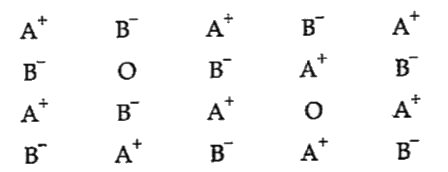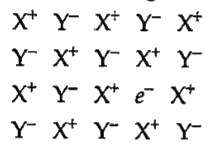Examine the given defective crystal :

Answer the following questions.
Is the above defect stoichiometric or non-stoichiometric ?
The given defect is stoichiometric since the number of cations and anions are missing from lattice sites unequal.
Topper's Solved these Questions
- SOLID STATEBOOK - SURA PUBLICATIONCHAPTER - SOLID STATEEXERCISE - LONG ANSWER
12 Videos
- SOLID STATEBOOK - SURA PUBLICATIONCHAPTER - SOLID STATEEXERCISE - HOTS
3 Videos
- SOLID STATEBOOK - SURA PUBLICATIONCHAPTER - SOLID STATEEXERCISE - VERY SHORT ANSWER
28 Videos
- P-BLOCK ELEMENTS - IIBOOK - SURA PUBLICATIONCHAPTER - P-BLOCK ELEMENTS - IIEXERCISE - UNIT TEST ( III. ANSWER IN A PARAGRAPH :)
6 Videos
- SURFACE CHEMISTRY BOOK - SURA PUBLICATIONCHAPTER - SURFACE CHEMISTRY EXERCISE - UNIT TEST ( LONG ANSWER )
2 Videos
Similar Questions
Examine the given defective crystal :

Answer the following questions :
(i) Is the above defect stoichiometric or non-stoichiometric ?
(ii) Write the term used for this type of defect. Give an example of the compound which shows this type of defect.
(iii) How does this defect affect the density of the crystal ?
View SolutionExamine the given defective crystal :

Answer the following questions :
(i) Is the above defect stoichiometric or non-stoichiometric ?
(ii) Write the term used for this type of defect. Give an example of the compound which shows this type of defect.
(iii) How does this defect affect the density of the crystal ?
View Solution
Knowledge Check
Examine the given defected crystal

Answer the following questions:
What type of stoichiometric defect is shown in the crystal ?ASchottky defect, decreases, NaCl and KCl etcBFrenkel defect, increases, As and Si etcCSchottky defect, increases, As and Bi etcDFrenkel defect, decreases, NaCl, KCl etcExamine the given defected crystal

Answer the following questions:
What type of ionic substance show such defect?ASchottky defect, decreases, NaCl and KCl etcBFrenkel defect, increases, As and Si etcCSchottky defect, increases, As and Bi etcDFrenkel defect, decreases, NaCl, KCl etcExamine the given defected crystal

Answer the following questions:
How is the density of crystal affected by this defect?ASchottky defect, decreases, NaCl and KCl etcBFrenkel defect, increases, As and Si etcCSchottky defect, increases, As and Bi etcDFrenkel defect, decreases, NaCl, KCl etc
Examine the defective crystal given below and answer the question that follows :

State if the above defect is stoichiometric or non-stoichiometric. How does this defect affect the density of the crystal ? Also, write the term used for this type of defect.
View SolutionExamine the given defective crystal :
X+Y−X+Y−X+Y−OY−X+Y−X+Y−X+OX+Y−X+Y−X+Y−
Answer the following questions :
(i) Is the above defect stoichiometric or non-stoichiometric ?
(ii) Write the term used for this type of defect. Give an example of the compound which shows this type of defect.
(iii) How does this defect affect the density of the solid ?
View SolutionExamine the given defective crystal
X+Y−X+Y−X+X+Y−OY−X+Y−X+Y−X+Y−X+Y−X+Y−X+Y−
Answer the following questions :
(i) Is the above defect stoichiometric or non-stoichiometric ?
(ii) Write the term used for this type of defect.
(iii) Why do silver halides show this type of defect ?
View SolutionExamine the given defective crystal :
X+Y−X+Y−X+Y−X+Y−X+Y−X+Y−X+e−X+Y−X+Y−X+Y−
Answer the following questions :
(i) Is the above defect stoichiometric or non-stoichiometric ?
(ii) Write the term used for the electron occupied site.
(iii) Give an example of a compound which shows this type of defect.
View SolutionExamine the given defective crystal :

Answer the following questions:
Give an example of the compound which shows this type of defect.
View Solution
